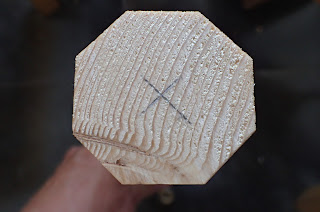I am lucky in that I often get to chat with Jonas from
Mulesaw when he is at work. He is chief engineer on the starship "Enterprise," and basically is sent to work for a month on his ship and then gets a month off at home where you and I rarely get to hear from him.
Jonas mentioned to me yesterday that one of the officers on his ship is interested in getting started in woodworking. I don't know this officer's name, but Jonas said he lives in Stockholm, so I'll call him "Sven."
Sven is single (aka: no one to keep him from spending all his money on Lie-Nielsen tools), and started by buying a set of Narex chisels and joined a woodworking club where he can go to use power tools like table saws, jointers, planers, etc.
I thought it might be an interesting mental exercise to recommend to him what tools he should consider.
Especially since I wasn't asked for my opinion.
This is fun because everyone is different, and there are lots of opinions out on the internet (including on this blog) of what a hypothetical "beginner" should buy to do woodworking. This case is a little different, because we know something about him.
Shannon Rogers recently put a video up on his blog, the
Renaissance Woodworker, his opinion of what a beginner should put in his kit first, and it looks an awful lot like what I recommend. Since we know that he already has a set of chisels and access to some woodworking machinery, I'll tweak my recommendation especially for Sven.
 |
| A great first project could be saw benches. |
Chisels
First, I'll recommend putting all of your new chisels away in the box and not using them, except for the smallest one, a medium one like a 10mm, and a wide one like a 25mm.
 |
| Photo credit: workshopheaven.com |
This might seem sacrilegious, focusing on fewer chisels will allow you to keep them in better shape and assist you greatly in your sharpening skills.
I find I very rarely need a chisel that is a specific size, and I have gotten by just fine by using a small number of chisels like this for a few years now.
If you don't believe me, remember I said so when in six months you reach for a chisel out of your nice graduated set and choose one not because it is the exact size you need, but because that one is the least dull of all of them. Keeping seventeen chisels razor sharp and perfectly tuned is much more difficult than keeping three that you use all the time that way.
After you get used to these three chisels, you can then add another one or two into your working set when you have a reason to do so.
Planes
I still need to stick with my recommendation of a jack plane being your first plane. If you choose a Lie-Nielsen #5, it will work perfectly right out of the box. Take a close look at a bevel up jack, too. This could be the answer for you. I really like mine and use it to do an awful lot. Stick with one blade for now (It's easy to get caught up in buying three different blades that you don't need). If you get the Veritas, you have the option of the A2 blade (like the Lie-Nielsen), O2, or PM-V11, Lee Valley's proprietary powdered metal blade. I would go for the O2, or maybe the PM-V11 if you want to spend a bit more. You'll also get excellent results out of an A2 blade. At this point, you don't know what you prefer yet, so it probably doesn't matter.
Another option would be to get a good vintage plane. Bailey style planes were made for a long time in Sweden, and those are awesome because they come with a blade made by one of the most fantastic tool steel blade makers of all time, such as E.A. Berg. The plane bodies themselves are of widely varying qualities, in my experience, so if you go this route you would benefit picking out your prospective vintage Swedish plane with the help of an experienced hand tool junkie. I'm sure Bengt would love to help.
I would recommend using this one plane for a while to get the hang of it, and if you think you need more planes, get a smoother (probably a #4, or maybe a #3 if you like that better), and then a #7 jointer (or a #8, if you can find one).
 |
| My vintage Sargent planes. A #4 size and a #8 size. They work every bit as good as a Lie-Nielsen now that I've tuned them up. |
Jonas said he recommended to you one of Veritas' moving filetster planes. I hadn't really thought of this as a plane for beginners, as they are pretty expensive, and they are not absolutely necessary. If there is money burning a hole in your pocket, you could do worse. This plane works like crazy right out of the box. Adding it to your kit sooner rather than later will have it's biggest reward when doing dovetail joints. Of course dovetails are possible without it, but this plane will make the inside corner of your joint look like you've been making dovetails for decades.
Other Tools
Check out my
series of posts about hand saws, sharpening equipment and layout tools. I still stand by those.
Except that I've moved to oil stones. I suppose I need a blog post about those, now.
What else should Sven spend his hard earned Starfleet pay on? I know there are about 50 million more opinions out there. Let's here some in the comments!


















































